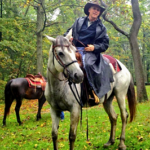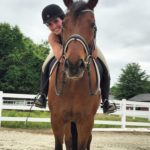
“You have to kill it!” Kimberly shouted.
“Okay,” I said, “But, could you get a little farther back from that thing, please?” I ran to the garage and grabbed our axe. I jogged back to where Kimberly stood holding Hazel by the collar. Both of them were staring about 10 feet in front of them at a snake coiled in the grass near our tobacco barn-turned-shavings building. As I approached, the snake bolted for the nearby underbrush and brambles. As soon as it stretched out to flee–which it did at lightning speed–the beautiful hourglass pattern of chocolate brown, mocha and beige was clear, as was the copper-colored head.
I swung the axe hard and fast, but the snake was faster. It was obviously more experienced at fleeing danger than I was at killing pit vipers. I buried the entire axe head in the grass, and watched the snake–now only a few inches shorter–disappear into the thicket. A little nub of its tail twitched in the grass.
“Well,” I sighed, “I almost got it.” Macy and Sascha approached and began attacking the twitching piece of tail. “I’m just glad no one got hurt.”
“I’m lucky I saw the snake,” Kimberly said, wiping sweat from her forehead. “It wasn’t even moving. I nearly stepped on it.”
I immediately felt conflicted. I didn’t want Kimberly or any of our “children” to get bitten, but did I have to kill the snakes? Fortunately, the beauty of human culture is its rich collection of knowledge passed down with each generation. So, when faced with an issue about which I know little, I conduct research in that collection of knowledge. I don’t have any snake books or sets of encyclopedias (remember those?), so I searched the Internet for a reputable site.
There were more snake websites than you could shake a stick at. When I found the ones featuring the Southern Copperhead, I found a mixture of advice. The wildlife-oriented sites seemed interested in minimizing human hysteria. Their “toned-down” language still yielded phrases describing the bites as “seldom fatal” and my favorite: “extremely painful, and may cause extensive scarring and loss of use.” These sites failed to qualify “loss of use,” but it didn’t sound like fun. Many sites agreed that Southern Copperheads don’t usually bite unless they’re grabbed or stepped on. On the downside, the well-camouflaged Southern Copperheads will typically freeze when they see you, making it more likely that you will step on them.
Eastern North Carolina is also home to three types of rattlesnakes (including the endangered Eastern Diamondback Rattlesnake), the Water Moccasin (or Cottonmouth) as well as the infamous and endangered Coral Snake. The Center for Disease Control states that 50 percent of venomous snakes’ defensive bites are venomless, or “dry.” Additionally, North Carolina has only had two reported human snakebite fatalities since 1970. Still, there are no guarantees, with anything, ever.
So, do I go on an axe-swinging, reptile-reducing rampage? Do I instead live and let live, but worry myself silly? (The latter is more my style.)
I had time to ponder the ethics and implications while I dealt with another issue. One of our new pastures had three neglected, though prolific crab apple trees. Though Ellie has some sense, I could see Vander eating himself sick on bushel after bushel of free treats. Snakes and apples? Yes, I suppose this truly is our Garden of Eden. But, let me tell you, if I find a talking snake I’m catching it and heading straight for Hollywood.
There were no snakes, talking or otherwise, near the apple trees. I hate cutting down trees, but I hate colicking horses even more. The chainsaw made short work of the trees. I dragged the limbs and trunks into a nearby pine grove and used a wheelbarrow to collect the apples. I pushed the overflowing wheelbarrow into the cool garage beneath the small apartment beside our house. The crab apple trees were gone, but maybe we could make some cider with the apples.
I couldn’t be too upset. Those apple trees were hardly the only fruit-bearers on our farm. We have 10 pear trees, two plum trees and four or five more apple trees behind the shavings barn. Additionally, there are two giant fig trees beside an old tobacco barn and several miles of scuppernong grape vines covering several of the old buildings, including a large, run-down “hog parlor.” It has stood unused for decades. The concrete slab is fine, though the wooden beams and walls are rotten in places. Holes in the tin roof let in rain, grape vines and sunlight. It’s a quiet, pretty place in late afternoon when the sun shines through the canopy of leaves. It’s a great place to stand and eat fresh figs.
Eastern North Carolina is home to thousands of abandoned, wooden farm houses and barns. After the last farmer moves out and the final bales of golden, cured tobacco leaves have been sent to market, the buildings remain. Very few are knocked down–most are left to the elements, eventually rotting and collapsing. Outlasting the buildings are the late nineteenth-century family graveyards. These are modest collections of bleached headstones, most bearing the same last name, all protected by a fence of rusted, wrought iron. Naturally, each graveyard contains the headstones of a few infants or children as a testament to harder times. These graveyards can be found along nearly every country road. (If you can believe it, there’s even one inside a fenced-off, grassy area in the parking lot of Wilson’s primary shopping mall.) Eastern North Carolina is not quick to let go of its history. Many of the small farming families are gone, but the larger farmers who now tend the land simply work around the graveyards and old buildings, seemingly out of respect. It’s strangely romantic.
Because of the historic buildings on our property, our new horse farm has a bit of that romance. Another nice touch: We’re surrounded by farmland. Our little homestead is in the center of about 50 acres of cotton fields. Beyond the cotton are fields of corn and tobacco. Arguments about the ethics of big tobacco or debates over the price and proper use of corn notwithstanding, this is a peaceful, beautiful countryside. Miles and miles of riding trails wind through the surrounding fields. I hope you’ll forgive my descriptive digression. I assume you read these stories because you, too, love the romance of wild things and places–horses and farmland being two prime examples.
“Wild” definitely describes the lush countryside of eastern North Carolina. Wild plants, vines, trees, birds, deer, rabbits, the occasional bear and–oh yeah–snakes. I almost forgot about those guys. What’s an animal lover to do? Snakes keep the rodent population in check. Snakes can also kill your cats and dogs and could certainly injure a person or horse, with debilitating results. Removing the heavy underbrush from around the old buildings will help all concerned parties. Beyond that… well, maybe I’ve been in the country too long, but I found a great recipe for snake chili. Like with the crab apple trees, I do my best not to waste food. So, if I have to kill a snake, I’m going to eat it. Kimberly assures me, however, that I’ll be eating any batches of copperhead chili all by myself. Let me just add that if there are any problems involving skunks, opossums or nutria that need to be “put down,” those will just be chalked up as a waste. I’m sorry. I’ll eat just about anything, but I have to draw the line somewhere.
Another “wild” thing I’ve got to contend with is the garden we inherited from Dean, the previous owner. It looks like something out of Joseph Conrad’s Heart of Darkness. If what’s growing beneath the grass and weeds is just half of what Dean described, we’re in for a mess of vegetables. The garden will have to wait, though. I have another stall to build. Kimberly and I have a series of appointments in the next few days to check out some prospective broodmares and we’re hoping to bring one home.
Of course, we want a mare who’ll give birth to a beautiful baby with great conformation. I know, who doesn’t? But the mare’s breeding and bloodlines can be revealed on websites or over the telephone. I think personality is as important as anatomy, and we want to meet these mares. In my limited experience, horses seem to lack both the desire and ability to conceal who they are. True to their wild nature, horses aren’t liars. In the first few moments you can usually tell if you and the horse will be a good match. I’m looking forward to meeting some new horses and finding a good mom.
I guess I’d better get started on that stall… and I will, just as soon as I finish this handful of figs.
Jeremy Law and his wife, Kimberly, live on a small farm in North Carolina.
Read Jeremy’s other columns in EquiSearch.com’s Humor section, and share your comments in the forum.







